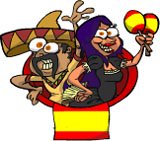The Ten Most Important Spanish Verbs - Top 10
Here are the ten most important Spanish verbs. Click on the verb links to see its full conjugations.
- ser - to be, when referring to what something is.
- estar - to be, when referring to how something is. Very important for constructing phrases like "I am doing..." The fancy word for these is the progressive tenses. Click here for more on the difference between these two forms of 'to be' - ser and estar - a whole book has even been written on the topic.
- ir - to go, an especially important verb because it is used to construct the forms like 'going to' as in I am going to do something. This acts as an easy and useful way to express a future tense.
- tener - to hold. Also important for common phrases like I am cold, I am hot, I am hungry, I am twenty. Spanish speakers 'have cold' or 'have heat' rather than are cold/hot/ hungry etc.
- haber - to have. This verb and its conjugations are used to form phrases like 'I have gone, I had gone, you would have gone, they will have gone...', etc. These are called compound tenses. Because haber is used as a 'tool' to build these other tenses it is called an auxiliary verb.
- hacer - to do or to make. There are lots and lots of idiomatic expressions with this verb and a few tricky conjugations. Check out the memory trigger of the HAG HISSING while MAKING HARE stew...
- querer - to want. This is a great verb to master because you can tack any other verb infinitive after it, and this will enable to make lots of phrases. Each new infinitive verb that you learn, will form another word that you can use. Verbs that function this way are called modal verbs, and another two follow in this list - deber and poder.
- deber - to have to. Another useful and versatile modal verb.
- poder - to be able to. Another powerful modal verb to add to your inventory. Love the pic with the girl with PODS of peas in her hair ...
- decir - to say. To remember this word decir a Memory Trigger in picture form will help you.
How have we decided that these are the ten most important Spanish verbs? Well, a combination of word frequency lists and a bit of judgement. Obviously if you are learning Spanish you simply have to know these, and a few hundred other verbs! To see them all fully conjugated check the links to their verb tables.
Why so many of the most powerful common Spanish verbs irregular?
All these ten most important Spanish verbs are irregular. Why? Well it is because directly as a of their 'commonness' and high frequency of use. Any verb that is common gets used a great deal, and therefore becomes subject to twisting, contortion, slanging and bending. The more it is used, the more it is changed and the more likely one of its forms or conjugations gets morphed into something else.
So these common verbs just have to be learned. Go through their our verb tables daily, until you master them, going along the rows, and vertically down the columns.
Top 10 Spanish Verbs
6 Important Things to Know about Learning the Ten Most Common Spanish Verbs
- Verbs are one of the more difficult areas for the English speaker who is learning Spanish. There are 14 major tenses in Spanish. There are several ways to speed up your verb learning, and make that learning a more efficient process. Below are some suggestions.
- Learn the verb patterns: There are 3 main types of verbs in Spanish. Each is grouped by its ending.
- AR verbs: The biggest group of verbs in Spanish are those words ending in AR. About 85% of Spanish verbs end in AR, and most of these (about 67% - over 6,500 verbs) follow the standard AR pattern.
- ER verbs: About 8% of Spanish verbs end in ER, and ...
- IR verbs: 7% end in IR
- Learn the endings: Part of learning the verb patterns described above is learning the verb endings. Spanish verbs all have unique endings for each pronoun (I, you, he, she, we, they etc).
- Spanish speakers drop the pronouns: To make Spanish verb learning a little more tricky for anglophones, they usually do not use the words for I, you, he, she, we, they (personal pronouns) when speaking. This is because each of the verbs related to these pronouns has a unique ending. So, given that the ending of the conjugation is unique, there is no need for them to state the pronoun, because it is implicit in the verb.
For example: Take the verb hablar which means 'to speak'. It ends with the letters AR, so it is an AR verb. I in Spanish is yo, you is tu.- I speak: yo hablo
- you speak: tu hablas
- AR verbs for I (yo) end in o.
- AR verbs for you (tu) end in as.
Get used to seeing and hearing the conjugations with and without the pronouns. - Do a verb table a day. Do one of our verb tables in full every day. It takes about three minutes to do each one in full, by row (tense), and by column (pronoun). These ten most important Spanish verbs take longer than the regulars, because they ave their unique quirks and twists. But once you have done them you will speed up by learning the various verb groups.
- Use 'em or lose 'em: The more you practise the better you will get. If you don't have a teacher, or native speaker friend, you can always take telephone lessons. These allow you to concentrate on your speaking and listening. There are lots of Spanish teachers that advertise on the internet who will teach Spanish over the telephone. This is a very effective way to practice.
Check here for more on learning and REMEMBERING the ten most important Spanish verbs.
| Ten Most Important Verbs in Spanish Related Topics and Links |
|
Spanish Bescherelle A vital tool for the Spanish learner, the Bescherelle is a book that lists all the different Spanish verb patterns (not just the ten most important Spanish verbs). Spanish Verbs List Lots of colour-coded verb tables of Spanish verbs. Llevar- the Spanish for take, carry or wear Remembering this verb is made easier with a cartoon Memory Trigger. |
| |
200 Words a Day! Accelerated Language Learning
Learn Spanish |
Learn French |
Learn German |
Learn Italian |
Learn Welsh |
200 Words a Day! Spanish verb learning made easier - Learn the TEN MOST IMPORTANT SPANISH VERBS.
200 Words a Day! and Exceltra
©Copyright
2004-2023 All Rights Reserved
Learning the Ten Most Important Spanish Verbs










New! Comments
Have your say about what you just read! Leave us a comment in the box below.